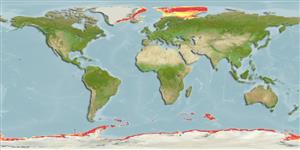Malacostraca |
Isopoda |
Aegidae
Environment: milieu / climate zone / depth range / distribution range
Ecology
Benthopelagic; depth range 40 - 710 m (Ref. 3113). Polar
Northeast Atlantic and the Antarctic.
Length at first maturity / Size / Weight / Age
Maturity: Lm ? range ? - ? cm
Life cycle and mating behavior
Maturity | Reproduction | Spawning | Eggs | Fecundity | Larvae
Members of the order Isopoda are mostly gonochoric. Mating behavior: Mating usually occurs before and sometimes during the parturial molt. Sperm transfer is indirect. Life cycle: Eggs are brooded in the marsupium, which later hatch into manca postlarva before developing into adults.
Brey, T. and A. Clarke 1993 Population dynamics of marine benthic invertebrates in Antarctic and subantarctic environments: are there unique adaptations? Antarc. Sci. 5(3):253-266. (Ref. 2590)
IUCN Red List Status
(Ref. 130435: Version 2025-1)
CITES status (Ref. 108899)
Not Evaluated
Not Evaluated
Threat to humans
Human uses
| FishSource |
Tools
More information
Trophic EcologyFood items (preys)
Diet composition
Food consumption
Predators
Life cycleReproductionMaturityFecunditySpawningEggsEgg developmentLarvae PhysiologyOxygen consumption
Human RelatedStamps, coins, misc.
Internet sources
Estimates based on models
Preferred temperature
(Ref.
115969): -1.4 - 3.6, mean -0.1 (based on 1454 cells).
Resilience
Low, minimum population doubling time 4.5 - 14 years (K=0.12).
Price category
Unknown.
